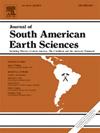Salicas组沉积古环境:阿根廷中西部拉里奥哈省Pipananco盆地东南部中新世演化
IF 1.7
4区 地球科学
Q3 GEOSCIENCES, MULTIDISCIPLINARY
引用次数: 0
摘要
从Salicas组的相分析,它被解释为一个河流分流系统,包括沙丘沉积和风成地幔。该系统显示了古土壤、生物扰动、根结和碳酸盐结,表明富碳酸钙的砂质沉积物经历了反复的干湿循环。这些特征表明气候是季节性的。这些沉积矿床连同已鉴定的粘土矿物如伊利石和高岭石,与半干旱气候有关。在晚中新世地层沉积期间,该沉积体系的发育表现为一个输入区较远的准平原古隆起,至少在该组下部地层中发育了一个渐进不整合。本文章由计算机程序翻译,如有差异,请以英文原文为准。
Depositional palaeoenvironment of the Salicas Formation: miocene evolution in the SE of the Pipananco Basin, La Rioja Province, central-western Argentina
From a facies analysis of the Salicas Formation, it is interpreted as a fluvial distributary system that includes dune deposits and eolian mantles. This system shows paleosols, bioturbations, rhizoconcretions and carbonatic concretions, suggesting calcium carbonate-rich sandy sediments subjected to repeated wetting and drying cycles. These characteristics indicate a seasonal climatic regime. These sedimentary deposits together with the identification of clay minerals such as illite and kaolinite are associated with a semi-arid climate. The development of this depositional system manifests a quasi-plain palaeorelief with a remote input area, during the period of deposition of these Late Miocene strata and with the development of a progressive unconformity at least in the strata of the lower section of the Formation.
求助全文
通过发布文献求助,成功后即可免费获取论文全文。
去求助
来源期刊

Journal of South American Earth Sciences
地学-地球科学综合
CiteScore
3.70
自引率
22.20%
发文量
364
审稿时长
6-12 weeks
期刊介绍:
Papers must have a regional appeal and should present work of more than local significance. Research papers dealing with the regional geology of South American cratons and mobile belts, within the following research fields:
-Economic geology, metallogenesis and hydrocarbon genesis and reservoirs.
-Geophysics, geochemistry, volcanology, igneous and metamorphic petrology.
-Tectonics, neo- and seismotectonics and geodynamic modeling.
-Geomorphology, geological hazards, environmental geology, climate change in America and Antarctica, and soil research.
-Stratigraphy, sedimentology, structure and basin evolution.
-Paleontology, paleoecology, paleoclimatology and Quaternary geology.
New developments in already established regional projects and new initiatives dealing with the geology of the continent will be summarized and presented on a regular basis. Short notes, discussions, book reviews and conference and workshop reports will also be included when relevant.
 求助内容:
求助内容: 应助结果提醒方式:
应助结果提醒方式:


